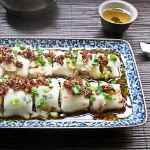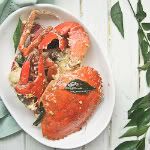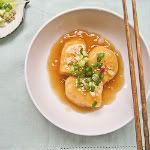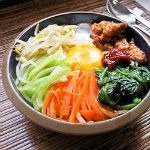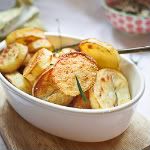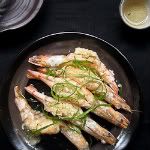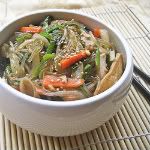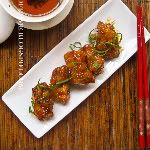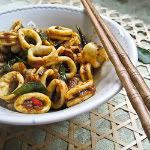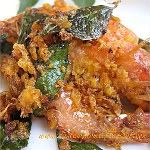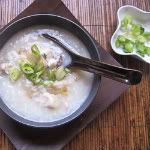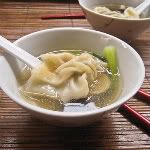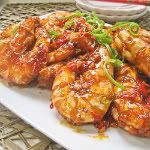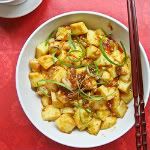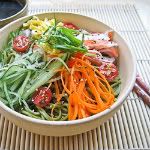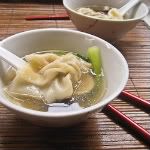Monday, August 30, 2010 |
Labels:
Malaysian recipes,
Shrimp Recipes,
Spicy,
Vegetables
|
11 Comments »
Petai or stinky beans cooked in spicy chilli paste is one of my favourite Malaysian dishes. Despite its' namesake, I don't find these beans stinky at all! The spicy and aromatic chilli paste goes perfectly with the beans and one usually adds shrimp or anchovies as the second ingredient. Petai is also known for some nutritional benefits where it is beneficial especially to diabetic patients due to its' natural blood glucose lowering properties. Petai gives off a very unique flavour, a little pungent but tastes satisfyingly delicious. Tamarind is also usually added that provides a pleasing sour note, drawing out the natural sweetness of the beans.
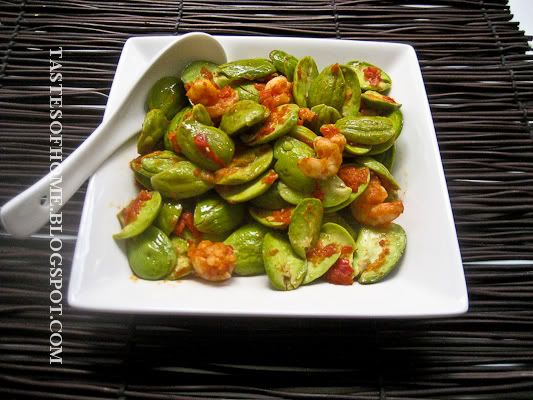
Whole petai, pre-cooking
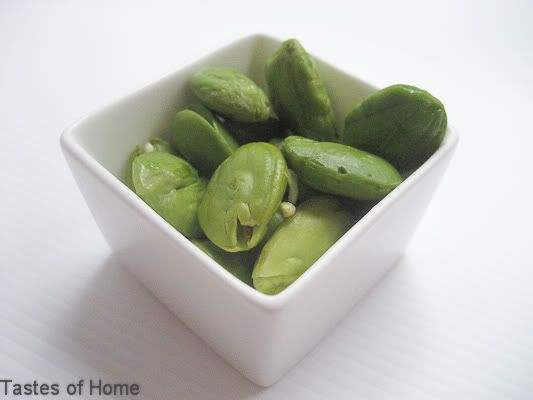
Cooking petai can be a little time-consuming though as one has to remove the tiny seed in each bean as the seed is rather bitter. I read also that petai is supposed to help with depression, if so - this is definitely a more low calorie way to beat the blues than chocolate!
I am planning to submit this entry to Weekend Herb Blogging event hosted this week by Janet of Tastespace. Please go to her blog to check out the details if you want to participate.
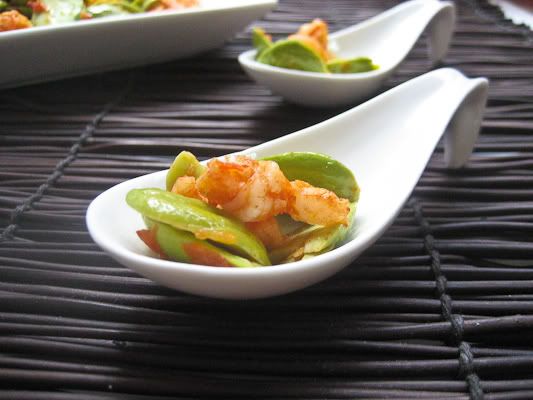

Wednesday, August 25, 2010 |
Labels:
Asian Soups,
chinese comfort food,
Chinese soups,
tofu recipes,
老火汤
|
12 Comments »
As most of my readers may realise by now, I am a huge fan of Cantonese slow-fire soups (老火汤) which is essentially soup that is simmered over low heat for at least a few hours, hence the term 'slow-fire'. Slow-fire soups are usually a clear broth made with some meat and flavoured with the vegetable of choice. Today, I would like to feature a very popular soup ingredient, the salted vegetable or known as 'ham choi' in Cantonese which apart from adding rich flavour to soups, is said to have 'heat-reducing' properties.

There appears to be many variations to this soup where instead of pork, one can opt to use duck. When I was browsing through a Nyonya cookbook, it appears that they like to add tamarind as well to the soup which adds a nice sour note to the soup. I opted to use tomatoes instead which also provided an appetizing note as I had tofu in my list of ingredients and I thought they went better together.
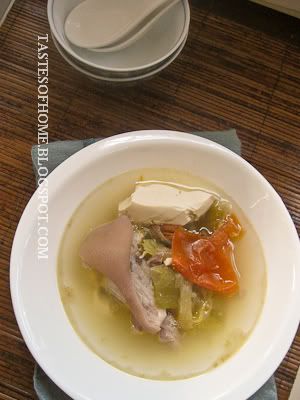
Whenever I use Chinese smoked ham, I do not need to add salt to the soup which I prefer, see my Chinese sharksfin melon soup where I wrote briefly on this yummy ingredient.
Salted vegetable, soaked in water
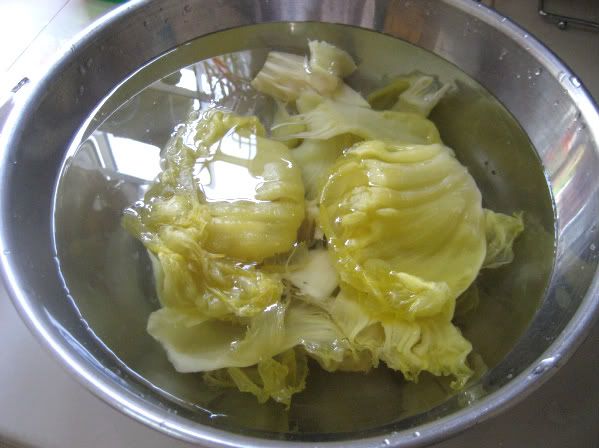

Monday, August 23, 2010 |
Labels:
Chinese recipes,
Quick meals,
Spicy,
Stir-fry
|
7 Comments »
This stir-fry is not the usual variety of vegetables but rather a fruit, the pineapple to be exact. This is a favourite family dish of ours, I don't think I've ever seen this dish in any Chinese restaurants but I could be wrong. Anyway, this pineapple stir-fry is tangy, sweet, fresh and spicy! The spiciness is a clean type of spiciness and comes from the red chilli peppers used in the dish.
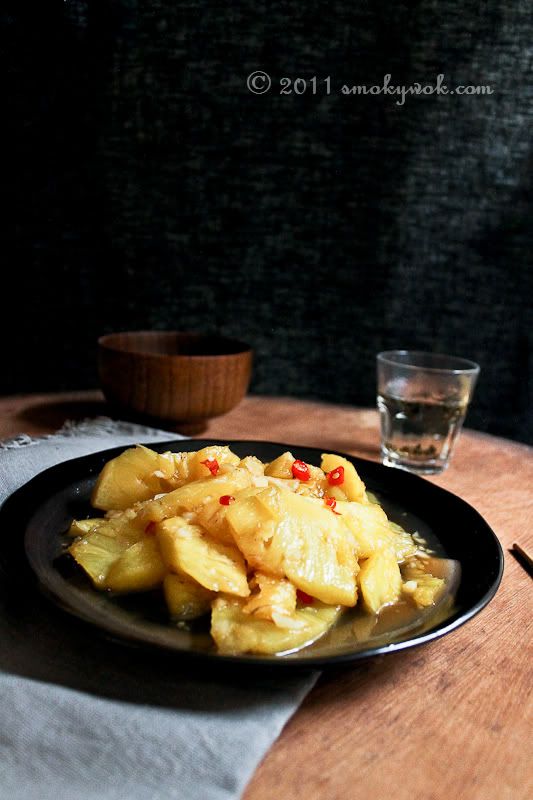
Pineapple is more commonly used in Chinese cooking as the accompaniment to a main ingredient, however this time pineapple is the main ingredient of the dish - hence, it is important to try to use fresh pineapple as opposed to the canned variety. Stir-frying a fruit with chilli peppers may be a little out of the ordinary especially for the more commonly seen Chinese cuisine, however I promise that this dish is extremely tasty!
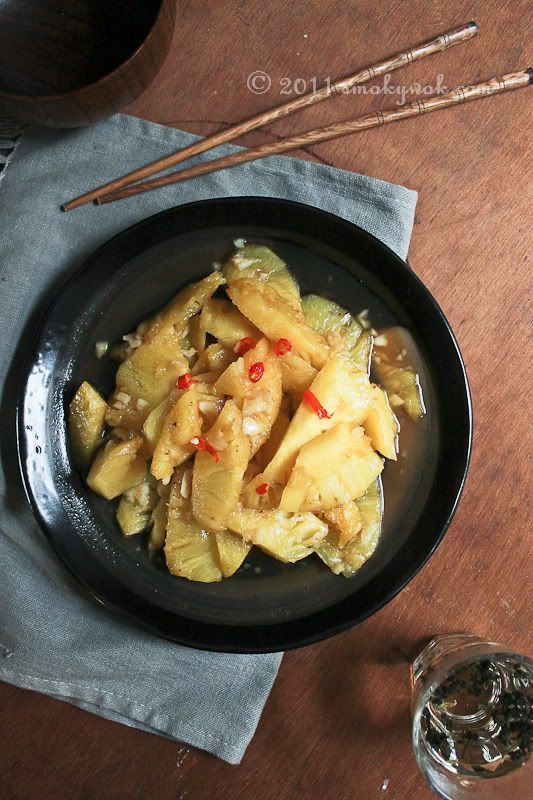
It was interesting too that I was just reading a Nyonya cook book recently and I found a recipe for pineapple curry - perhaps using pineapple is more popular than I thought. However, Nyonya cooking is heavily influenced by Malay and Indian cooking styles so that might explain why pineapple as the main ingredient is hardly seen in 'common' Chinese cuisine. By the way, I am very curious if you have ever had pineapple cooked this way - do let me know.
Pleasing to the eye and the palate..

Friday, August 20, 2010 |
Labels:
Asian Comfort Food,
egg recipes,
Quick meals
|
7 Comments »
French beans omelette are a definite childhood favourite of mine - this dish is a very popular home style Chinese dish and I'm sure that most Chinese households have served it in one interpretation or the other. Quick and tasty, this humble egg dish is best served with rice in my opinion. You can get this prepared under 15 minutes and with a temptingly short list of ingredients, I hope you will give this recipe a try.
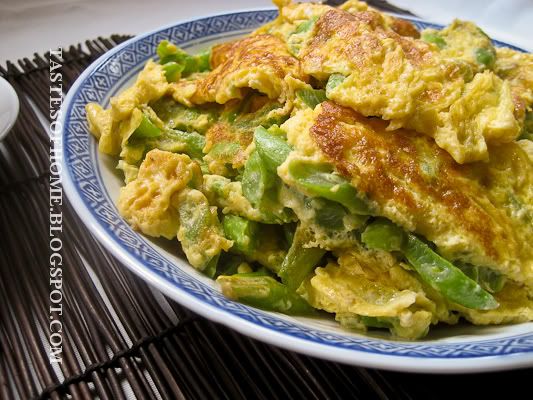
There is a good contrast of textures in this dish with the crunchy french beans ensconced within yummy and soft fried egg. As with most family-styled Chinese dishes, it's quite difficult to figure out how this dish came about - anyhow this is one of my favourite Chinese egg recipes, another one that comes to mind is the steamed salted egg with pork that is also open to many different (delicious!) interpretations. The french beans can also be easily substituted with four-angled beans for another variation.


Wednesday, August 18, 2010 |
Labels:
American Food,
Cakes,
Desserts,
Tea-time
|
6 Comments »
Recipe adapted from Savor America by Williams Sonoma.
I really love this cookbook published by Williams Sonoma, the photography is excellent of course but what I loved the most was that it provided a lot of interesting background to many American classics. Anyways, this is a twist on classic New York cheesecake as it uses a chocolate graham cracker crust instead of the regular pastry crust however I prefer oreos to graham crackers so I used crushed oreos intead. The recipe called for vanilla beans in the filling but I skipped it as I don't really like the bold flavour of the beans. My regular readers will notice that I hardly bake but after baking my lemonade cookies earlier, I must have caught the baking bug.
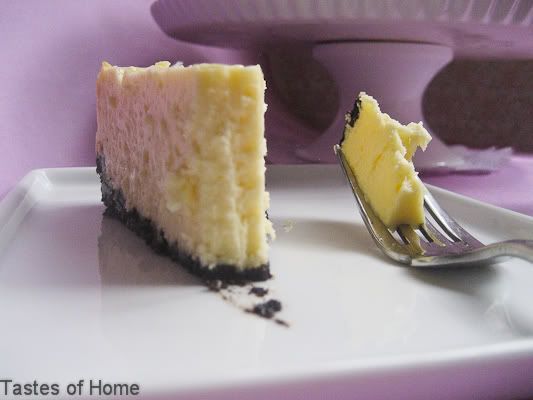
Baking or rather making a cheesecake is a different feat altogether - if you type in 'tips for cheesecake' in google, you will be sure to find a long list of tips on how to achive the 'perfect' cheesecake, the most common objective is to achieve a cheesecake with zero cracks. The secret apparently to achieving that is strictly no overbeating of the cream cheese after the eggs have been added as the protein in the eggs will trap the air hence the cake will crack once it cools as the air tries to escape. I was delighted that being the novice baker that I am, my cheesecake DID NOT crack!
I would like to thank my assistant today - Jon (SS) as well for being exceedingly helpful in the kitchen and this post and cake is dedicated to him as he is probably the biggest cheesecake lover I know!
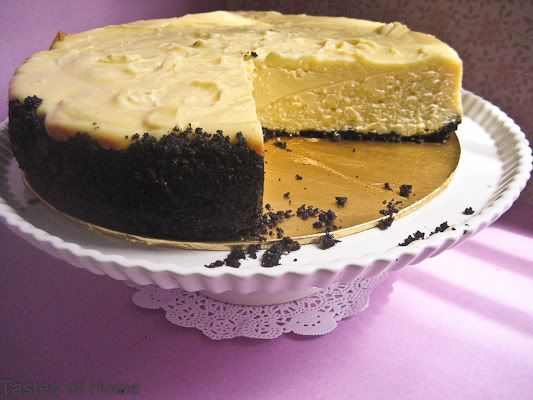
There seems to be endless debate as well on what really constitutes baking a New York cheesecake, so to err on the side of caution I must mention that this is probably a recipe adapted from baking the New York. I did not use a waterbath for my cheesecake as this recipe had flour in it. Flour or cornstarch is often used in cheesecake recipes to avoid overcoagulating of eggs which is the main cause of cracking.
After the cheesecake is done that is when the center still jiggles slightly when you shake (lightly!) the pan - turn of the oven but do not remove the cheesecake just yet and keep it in the cooling oven for another hour.
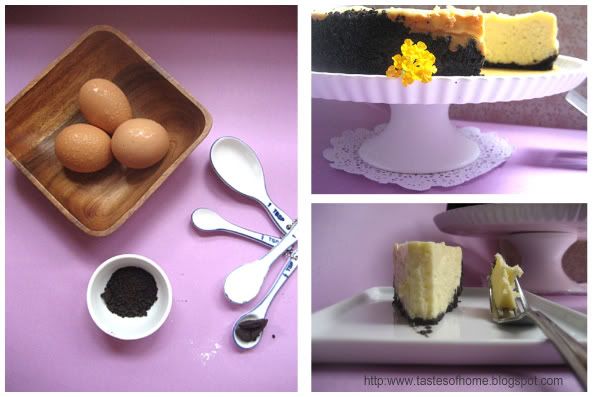

Sunday, August 15, 2010 |
Labels:
Asian Comfort Food,
Cantonese soups,
chinese comfort food,
老火汤
|
9 Comments »
May I serve another heartwarming and wholesome bowl of nourishing 'slow-fire' soup from my kitchen. I am such a fan of soups, especially Chinese soups that just soup can be meal in itself for me and the good thing is that I never tire of it. Slow fire soups or 老火汤 have to be simmered for a long time, about 5-6 hours, hence the term 'slow-fire' where the soup usually consist of a clear broth simmered with meat and another ingredient of choice. Today's feature soup is made with sharksfin melon which I think is a great substitute for the popular infamous Chinese delicacy of sharksfin soup. This fibrous melon resembles sharksfin when cooked as the threads separate and truly gives on the appearance of sharksfin - but only with more nutrition, less costs and most importantly ZERO guilt from killing increasingly endangered sharks.
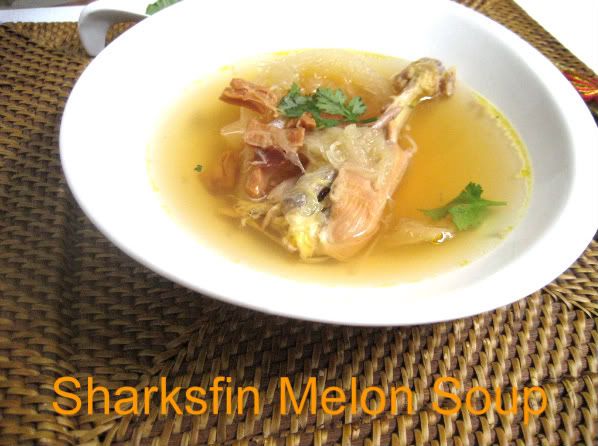
To me, 老火汤 is the ultimate comfort food, yes even more so than congee - and is also extremely simple to prepare at home, simply throw all the ingredients in the pot and boil merrily away, well almost that simple.
Slow fire soups are a specialty of Cantonese cuisine and depending on the main ingredient used, these soups are often believed to be tonics for strength and vitality.

Most of my recipes for Cantonese soups are derived from my parents' treasure trove of home recipes - for today's yummylicious soup, we used dried scallops, 'kampung' (free-range) chicken and Chinese smoked ham* to complement the sharksfin melon. The result was an extremely satisfying pot of irreplaceable 老火汤 (slow-fire-soup)!
* Chinese smoked ham or 金华火腿 (pictured on the right below) is an extremely flavourful ham that goes a long way in a lot of Chinese dishes, it provides a rich flavour especially in soups, almost like a 'magic' ingredient! A little goes a long way. I am most familiar with using this flavourful ham in Cantonese soups but they are often used in stews, stir-fries and also served on its' own simply steamed with some Chinese wine to cite an example. If you are unable to locate Chinese smoked ham, you can opt to use Virginia ham which is a good substitute.
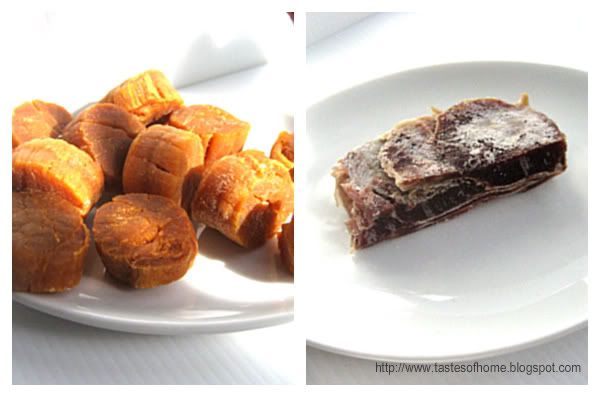

Friday, August 13, 2010 |
Labels:
American Recipes,
Desserts,
Tea-time
|
6 Comments »
Recipe from Perfect Light Desserts by Nick Malgieri and David Joachim
I am a lazier cook by nature in that I hardly bake as baking is so much more precise than just cooking in the kitchen which allows me more flexibility that is at least in my opinion and experience, BUT when I read this recipe, I decided to put on my baking hat again after a long hiatus. This is a great and easy recipe from 'Perfect Light Desserts', imagine having lemonade in the form of a cookie!
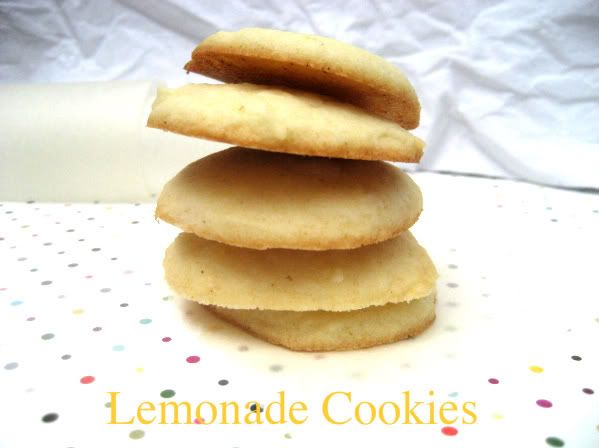
Apart from being light, chewy and delicious, these cookies are also relatively low in fat. These are drop cookies which means no rolling or shaping is required, just drop the batter onto your baking trays or cookie sheets and bake (lazy genes acting up again - not to mention I realised I am a klutz with a rolling pin!). I absolutely love the fresh and bright scent of these lemonade cookies, these will be perfect with a steaming hot cup of coffee or tea. Not having much of a sweet tooth myself, I prefer cookies or biscuits that are not too heavy and these fit the bill nicely. As these are drop cookies, I used a teaspoon to scoop up a rounded portion of the batter and then used a knife to slide it onto the baking tray. If you really want to be very precise, you can try using cookie scoops as well - small ice cream scoops will also do the job well.
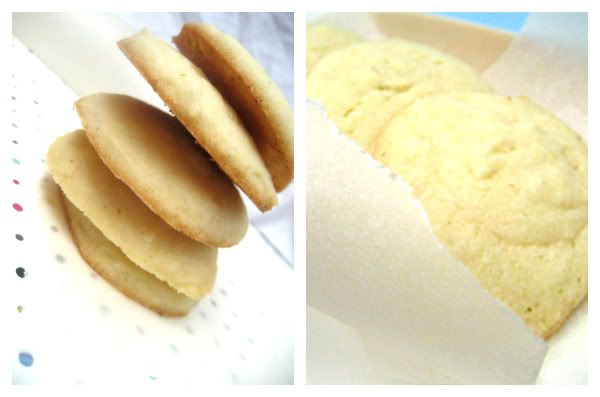
Update: I was pleasantly surprised that my simple lemonade cookies made the Top 9 in foodbuzz's daily. Thanks fellow foodbuzzers and editors!
Storage note: Store cookies between sheets of wax paper in a tin or plastic container with a tight-fitting cover.
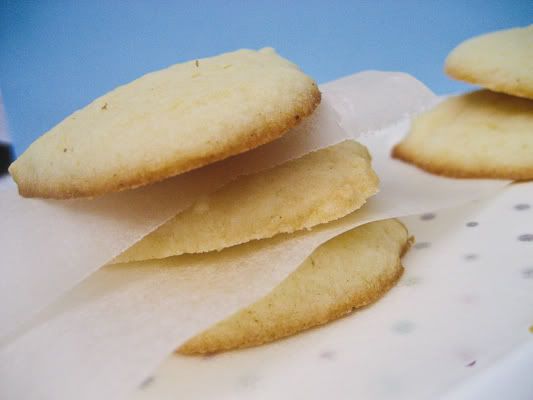

Wednesday, August 11, 2010 |
Labels:
Asian Comfort Food,
chinese comfort food,
Chinese food,
Noodles,
Quick meals
|
12 Comments »
This recipe for fried or rather stir-fried egg noodles is extremely simple, the only seasoning used is soy sauce. However, instead of light soy sauce, thick dark soy sauce is used as my mom prefers the richer flavour. The noodles used today are fresh egg noodles which are yellow in colour and usually sold in packets in the refrigerated sections of most Asian grocery stores. These noodles do not need to boiled before use and are ready for the wok. To my chagrin, I remember the first time I attempted to make this dish while I was studying in London, I thought I had to boil the fresh noodle before cooking them and of course I ended up with starchy lumps in my pot!

On another note, I thought it was interesting that according to some records, the origins of pizza and pasta can be traced back to China when the Chinese were the first ones to invent noodles and breads using the grain brought from the West via the Silk Road. Noodles are one of my favourite Chinese inventions and I just love how versatile they can be. This recipe calls for very little time in the kitchen and you can choose to omit or add ingredients according to your tastes. You can also add curry powder for some spice, take a look at my dry curry noodles with shrimp recipe.
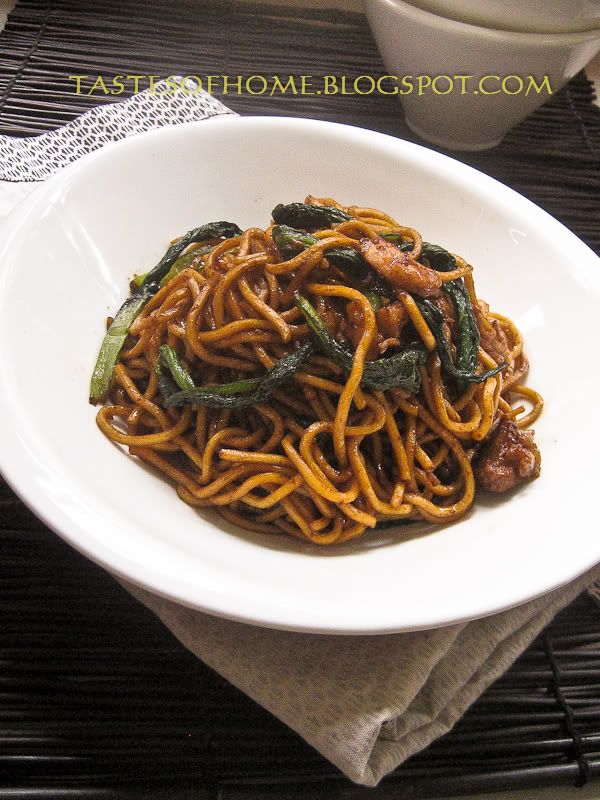
I will be sending this as an entry to Siri of Siri's Corner who is hosting this week's Presto Pasta Night created by Ruth of Once Upon A Feast. Check out her blog for more information if interested.
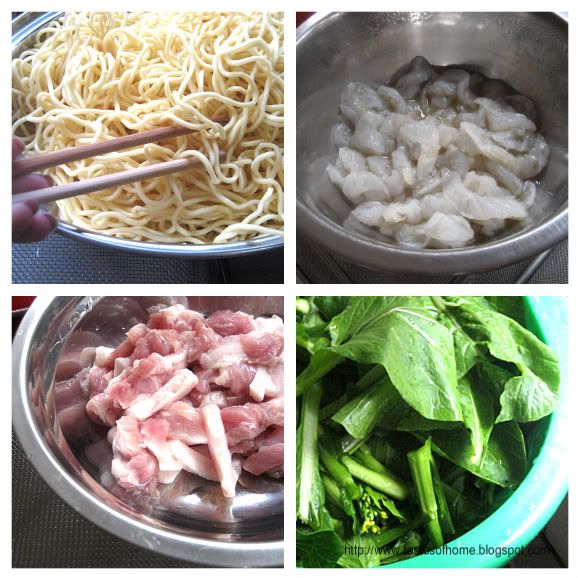

Monday, August 09, 2010 |
Labels:
chinese desserts,
pancakes
|
6 Comments »
Allow me to continue my recent fascination with Chinese desserts - today's feature is a sweet pancake recipe of my late Grandma whom we addressed as 'Popo'. According to my mom, my popo used to make this as a snack for them during their childhood days whenever my mom and her siblings craved something sweet. You probably won' t find these pancakes being sold anywhere as I think this recipe is something my popo created or improvised upon. Nevertheless, I think these pancakes are great little snacks that you can whip up with minimal ingredients at home anytime. The texture of these pancakes are a little chewy and I like them best with crispy edges. Since there are so little ingredients involved, the quality of the eggs used are of utmost importance to ensure the soft, sweet fragrance. Do try these at home and I hope you will like them - since these pancakes are sweet, they are best served with something savoury, but they are also good on their own with some piping hot coffee. My mom likes to serve them with some bacon.

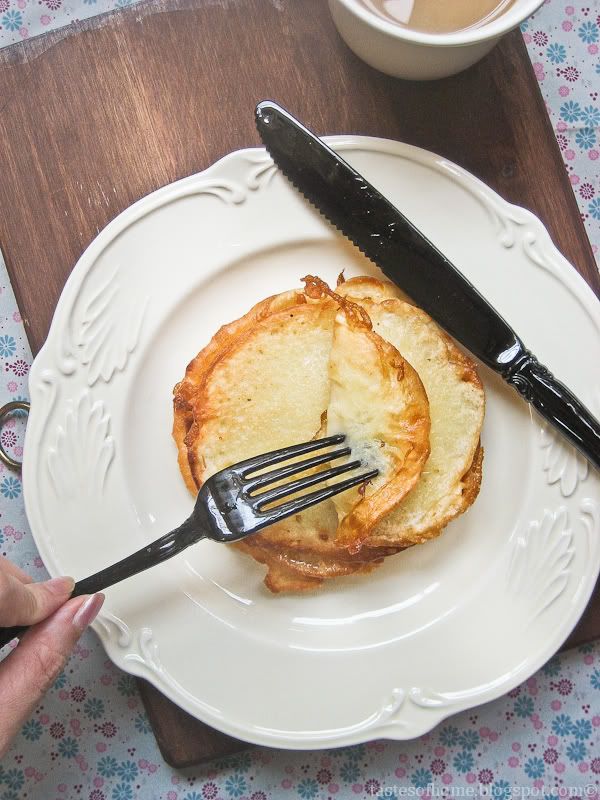
Step by step photo instructions after the jump.

Saturday, August 07, 2010 |
Labels:
asian desserts,
Chinese steamed cake,
Desserts,
Tea-time
|
24 Comments »
Steamed Chinese cakes are a childhood favourite of mine - the ideal steamed cake is fragrant, light and airy. This is the second time I am featuring Chinese steamed cake and this time I used superfine flour which I think increased the airiness of the cake. Steamed cake uses very little ingredients and is very easy to whip up at home. In my opinion the most important part is to make sure you use high grade eggs as the ingredient list does not involve any strong flavourings, the eggs produce a lot if not most of the fragrance to the steamed cake. I am sure that there are many different versions floating around and I think the different amounts of the ingredients used are adjusted according to individuals' preferences. Take a look at my other Chinese steamed cake recipe that has a slight variation on ingredients and used butter instead of cooking oil.
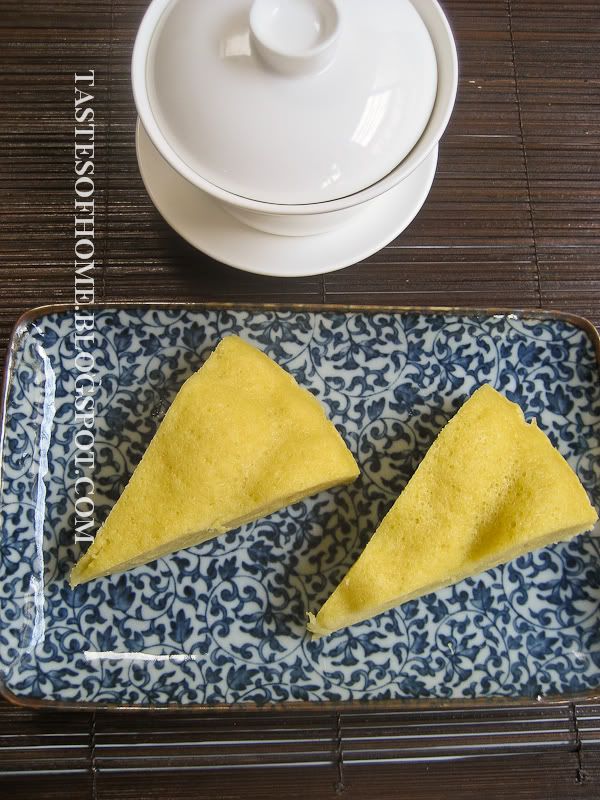
I think steamed cakes are a nice alternative to baked cakes at times and according to Chinese tradition, baked goods carry with it an element of 'heatiness' (热气) which is hard to explain in English. Essentially, traditional Chinese medicine advocates balance, hence there must always be the right amount of cooling and heat elements in one's body - consuming too much 'heaty' food will cause the body to lose said balance. Hence the steaming method is always almost considered the healthier alternative.
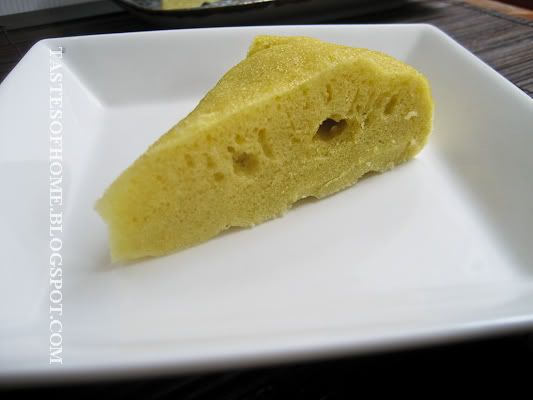
Step-by-step photo instructions below the jump.
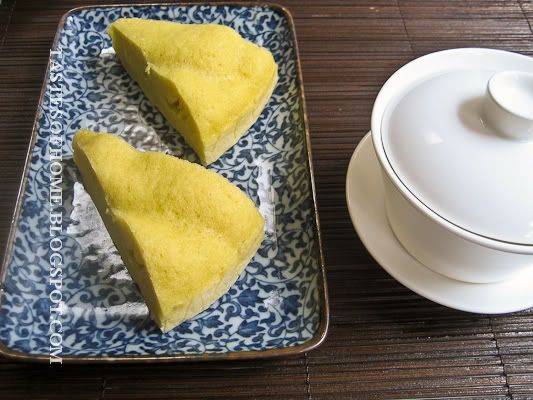

Thursday, August 05, 2010 |
Labels:
Asian Comfort Food,
Congee,
Pork recipes
|
7 Comments »
Congee or rice porridge is probably one of the best Asian comfort food I know of, especially to the Chinese people - we like to have congee when we're sick, when we're feeling cold or just because it is tasty. This is a very simple recipe for congee, spare ribs congee densely flavoured with dried oysters, dried scallops and peanuts for some added texture. Sprinkle some chopped green onions on top and your steaming hot bowl of tasty congee is ready to be served!
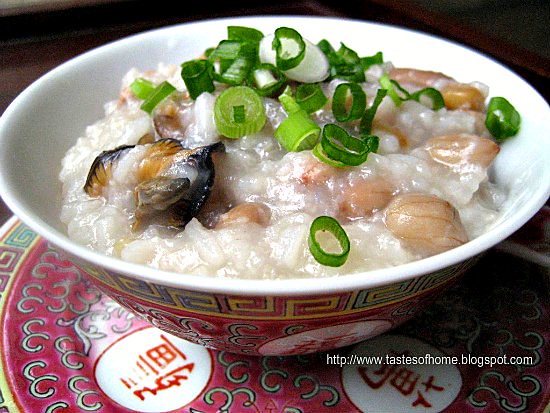
It has been said that dried oysters have been used in Chinese cuisine even before the Tang Dynasty (circa 618-907 CE). Dried oysters and dried scallops add rich flavour to many different types of dishes and are probably two of the top ingredients used in every Chinese kitchen. As one may gather, dried oysters, along with various other types of dried/ preserved food were probably invented as a means to ensure a continuous supply of food especially when refrigerators were not present at the time. Dried oysters or 'ho see' in Cantonese also mean good deeds hence dried oysters are abundantly used especially in festive seasons due to the auspicious connotations.
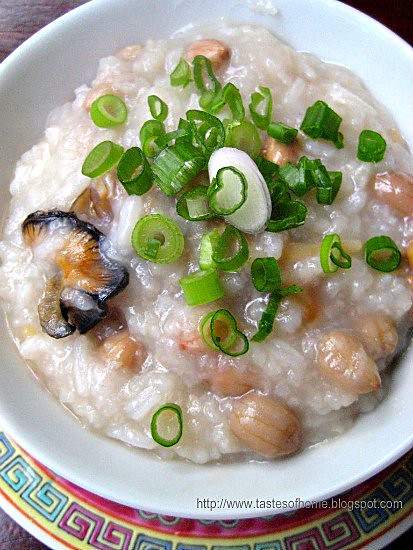
Congee is also often served with fried crullers or 'yau char kuey' which literally means deep-fried ghosts. Check out my congee with pork and preserved eggs recipe served with yau char kuey for the interesting story on why these yummy Chinese doughnuts have such a sinister-sounding name!

Note: As for the thickness of the congee, you can add more or less water depending on the consistency you desire which is a personal taste preference. I like to soak the rice before boiling to ensure a smoother consistency for the congee.

Sunday, August 01, 2010 |
Labels:
Chinese food,
pig's trotters,
Yuen Chun Recipes
|
14 Comments »
Braised pig's trotters is a very yummy and protein-filled dish that is familiar to most Chinese people. To the uninitiated, pig's trotters do look or sound rather exotic for eating. This dish has been cooked for years and has a distinctive and strong flavour courtesy mainly of the copious amounts of vinegar used. The version I am presenting today differs slightly from the classic pig's trotters in black vinegar traditionally served to women post-labour. This dish is considered nutritious as pig's trotters are low in fat and carbohydrates but high in natural collagen. One should definitely try this at least once -today's feature is a very simple recipe for tender, moist and succulent pork trotters cooked in an aromatic and sweet and sour sauce. For another 'exotic' recipe, try my braised chicken feet recipe, a Chinese classic and an extremely simple dish to prepare at home.
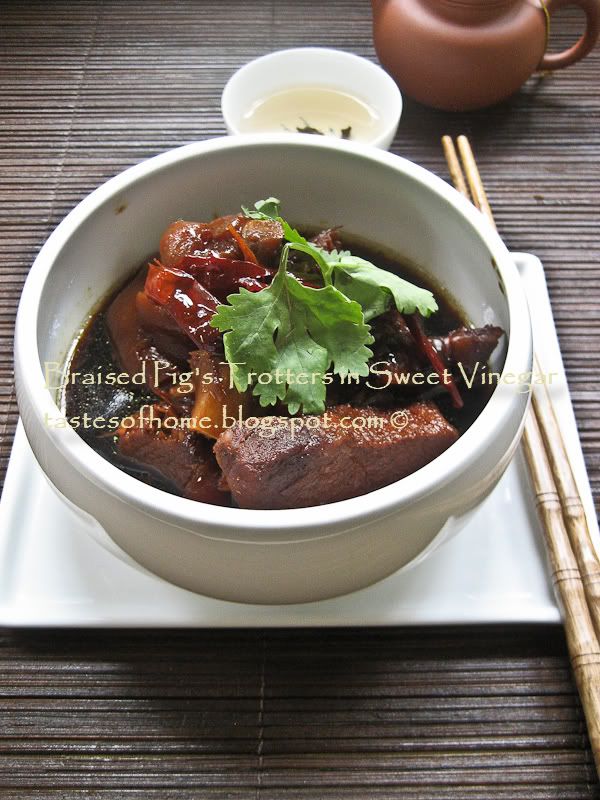
My version or rather my mom's version of this classic eschews ginger - the heat factor is supplied generously by the dried chilli peppers used in the recipe. Instead of black vinegar, white vinegar is used - I think this is more a personal taste preference, white vinegar is higher in vinegar content and produces a more sour taste compared to black vinegar where the latter may have more of an almost 'smoky' taste.


No content from this website including images, recipes, writings may be reproduced without prior consent from the author.





 Subscribe to Feed
Subscribe to Feed

































